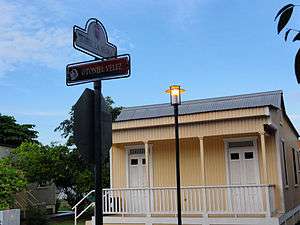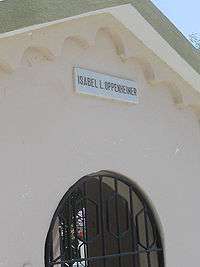Isabel Luberza Oppenheimer
| Madam Isabel "la Negra" Luberza Oppenheimer | |
|---|---|
_del_Barrio_Marag%C3%BCez%2C_en_Ponce%2C_Puerto_Rico_(DSC05441C).jpg) Isabel "la Negra" Luberza Oppenheimer, ca. 1950 | |
| Born |
Isabel Luberza Oppenheimer 23 July 1901[1] Ponce, Puerto Rico |
| Died |
4 January 1974 (aged 72)[1] Barrio Maragüez, Ponce, Puerto Rico |
| Cause of death | Shooting |
| Resting place |
Cementerio Civil de Ponce 18°00′49″N 66°37′57″W / 18.01352°N 66.63243°W |
| Occupation | Brothel owner |
| Years active | Mid 1930s - 1960s |
| Employer | Self-employed |
| Organization | Elizabeth's Dancing Club |
| Home town | Ponce, Puerto Rico |
| Net worth | $500,000 USD[2] |
| Height | 64" (5'4")[1] |
| Weight | 140 lb (64 kg)[1] |
| Children | Manuel Morales (adopted)[2] |
Isabel Luberza Oppenheimer[note 1] (23 July 1901[1] – 4 January 1974), better known as "Isabel la Negra", was a Puerto Rican brothel owner and madam in barrio Maragüez, Ponce, Puerto Rico.[3][4] Her name and her brothel, Elizabeth's Dancing Club, became part of Puerto Rican folklore both during her life and posthumously.
Early years and youth

Isabel Luberza Oppenheimer was born in the San Anton neighborhood of Ponce, Puerto Rico,[5] on 23 July 1901. Apart from her business as a madam, well documented in many Puerto Rican newspapers such as El Dia and El Vocero, not much is known about her early life. One widely circulated version is that Isabel left home as a young teenager to live with a wealthy man, only to find out that he was married.[6] Another version says she dated, and married, a much older man, a wealthy American.[7] A well researched and documented story of her life is presented by the prominent[8] criminal attorney and businessman José Ángel “Chiro” Cangiano. In his legal documentary "Receso del Tribunal: Vivencias Judiciales of Jose Angel Cangiano" ("Courtroom Recess: Judicial Experiences of Jose Angel Cangiano"), he debunks those stories and documents Isabel's true story: As a young girl of the poor lower class in Ponce, Isabel fell in love with the son of a wealthy Ponce upper class homeowner where her mother worked as a housemaid. The elegant gentleman, an young attorney, returned her love in various ways, including purchasing her a home, where he would later enjoy her cooking and would occasionally also invite his professional friends, including attorneys, judges, and prosecutors, for socializing with their wives. Their romance, however, ended abruptly when Isabel, walking downtown with her cousin Norma, recognized her wealthy boyfriend as the groom in the nuptial caravan that passed her during her boyfriend's unannounced marriage to another girl, also a member of Ponce's upper class. Emotionally affected by the experience and "in an bath of tears", Isabel told her cousin Norma that "the man that from that day hence wants to enter my house, has to pay a charge." Thus developed the beginnings of Isabel as a brothel owner.[9]
Business and career
From the late 1930s to the mid-1960s, she owned and operated her bordello in the municipality of Ponce. At that time prostitution was tolerated in Puerto Rico. Her bordello was allegedly visited by politicians, businessmen, clergy members, etc., although this remains conjecture.[6]
Dubbed by the public Isabel la Negra, she declared herself "Madame" of her brothel. Isabel had two brothels: one in Barrio San Anton and another one in Barrio Maraguez.[6] Some sources claim that, while her brothel businesses made her quite wealthy, the Catholic Church did not accept her donations because of her past and the nature of her profession;[6] but others state the she made many numerous well-received and significant contributions to the Catholic Church in Ponce.[9]
Death

Isabel la Negra was shot dead on 4 January 1974, an innocent bystander of a drug-related homicide which occurred near one of her establishments. She was 72 years old. She was buried at Cementerio Civil de Ponce.[6] The Catholic Church, which she had allegedly supported for many years, refused to accept her body into the Ponce Cathedral as part of the ceremonies for her burial. In spite, and some say as a consequence, of this, over 13,000 people attended her funeral anyway.[10]
Literary and media representations
Several of Puerto Rico's most important authors and filmmakers have been inspired by Isabel Luberza Oppenheimer's life and made works based on her experiences. In 1975, Rosario Ferré and Manuel Ramos Otero published two stories about Isabel la Negra in the literary journal Zona de carga y descarga. These stories were later reprinted in short-story collections by each author.[11][12][13]
In 1979,[14] a film about her life was released, starring Míriam Colón as Isabel, with José Ferrer, Raúl Juliá, Miguel Ángel Suárez, and Henry Darrow. The movie was titled Life of Sin, and was directed by Efraín López Neris.[15]
In 2006, Mayra Santos-Febres published a novel based on the life of Isabel la Negra titled Nuestra Señora de la Noche. The novel was published by Espasa-Calpe in Madrid, Spain ( ISBN 84-670-2136-5).[16]
Legacy
There is a street in Ponce, crossed by Papo Franceschi street, and named to the memory of Isabel La Negra at Barrio San Antón, the community where Isabel la Negra was born and raised.[17]
See also
Notes
- ↑ This name uses Spanish naming customs: the first or paternal family name is Luberza and the second or maternal family name is Oppenheimer.
References
- 1 2 3 4 5 Funeraria Jackie Oliver. Museum. Avenida Las Americas, Ponce, Puerto Rico. 15 February 2012.
- 1 2 Se resolvio el Caso de 'Isabel la Negra'!, foro.univision.com, 25 August 2006. (Commentary on Libres de pagar a Hacienda grupo herederos de "Isabel La Negra" by Mayra Santos Febres, El Nuevo Día. San Juan, Puerto Rico; retrieved 28 July 2012.
- ↑ López Rojas, Luis Alfredo. La mafia en Puerto Rico. San Juan, P.R.: Editorial Isla Negra, 2004, page 20, note 7; ISBN 1-932271-32-5
- ↑ Ramos Rosado, María Esther. La mujer negra en la literatura puertorriqueña. San Juan, P.R.: Editorial de la Universidad de Puerto Rico, 1999. ISBN 0-8477-0366-5
- ↑ José Ángel Cangiano. Receso del Tribunal: Vivencias Judiciales. Santo Domingo, Dominican Republic: Editoria Centenario. 2007, pg. 3.
- 1 2 3 4 5 Frances R. Aparicio. Listening to salsa: gender, Latin popular music, and Puerto Rican cultures Wesleyan University (1998), pp. 3, 45, 52, 54.
- ↑ Se Resolvio el Caso de "Isabel la Negra"! 25 August 2006. Maria Elena Salinas. Univision.
- ↑ Fortuño lamenta muerte de José Ángel “Chiro” Cangiano. Primera Hora. San Juan, Puerto Rico. 3 October 2011. Accessed 3 May 2018.
- 1 2 Jose Antonio Cangiano. "The People of Puerto Rico v. Isabel Luberza Oppenheimer." In, "Receso del Tribunal: Vivencias Judicales". Dominican Republic: Editoria Centenario. First Edition. 2007. page 5.
- ↑ Una vida llena de contrastes: Aunque no se ganó su sustento de la forma más encomiable, de alguna manera Isabel la Negra supo atrapar el corazón de muchos ponceños. Jorge L. Pérez. El Nuevo Dia. 6 January 2013. Accessed 3 May 2018.
- ↑ Ferré, Rosario. "Cuando las mujeres quieren a los hombres." In Papeles de Pandora, pp. 23-38. Mexico: Joaquín Mortiz, 1976; ISBN 968-27-0106-6
- ↑ Ramos Otero, Manuel. "La última plena que bailó Luberza", El cuento de la Mujer del Mar, pp. 47-68. Río Piedras: Ediciones Huracán, 1979.
- ↑ Cuentos de buena tinta, pp. 195-209. San Juan, P.R.: Instituto de Cultura Puertorriqueña, 1992; ISBN 0-86581-454-6
- ↑ Life of Sin movie at IMDb. Retrieved 14 September 2012.
- ↑ A Life of Sin (movie), fandango.com; retrieved 14 September 2012.
- ↑ Nuestra Señora de la Noche Archived 27 November 2010 at the Wayback Machine., Nuestra Señora de la Noche. Madrid: Espasa, Pozuelo de Alarcón. 2006; ISBN 84-670-2093-8
- ↑ Isabel la Negra street, Travel Ponce, 10 August 2009; retrieved 14 September 2012.